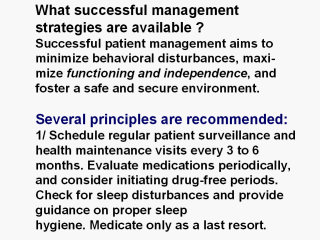| front |1 |2 |3 |4 |5 |6 |7 |8 |9 |10 |11 |12 |13 |14 |15 |16 |17 |18 |19 |20 |21 |22 |23 |24 |25 |26 |27 |28 |review |
 |
2/ Work closely with family and caregivers.
Establish and maintain an alliance with caregivers. Help them establish
medical and legal advance directives for patients and update the patient's
will early in treatment. Suggest that a trusted family member cosign any
important financial transaction and take care of paying bills. Discuss
long-term care placement in anticipation of future needs, so family members
have time to complete the arrangements and begin to make the necess-ary
emotional adjustment. Community resources, including respite care, are
important sources of help. Information and emotional support enhance quality
of life for patients and family and can delay nursing home placement. 3/ Establish programs to improve patient behavior and mood. Set up an exercise routine to continue safe ambulation for as long as possible. Help patients maintain social and intellectual activities as tolerated, especially important family events. Monitor safety and intervene when necessary. 4/ Encourage caregivers to modulate the environment. Dementia patients are sensitive to their environment and often do best with moderate stimulation. Too much stimulation may worsen confusion or cause agitation. Too little may lead to withdrawal. Encourage families to employ familiar surroundings to enhance mood and maximize existing cognitive functions; to promote a sense of security and predictability through daily routines; and to stimulate memory and orientation through conspicuous displays of clocks, calendars and to-do lists. Many patients benefit from links to the outside world through newspapers, radios and televisions. Use of simple sentence structure and frequent reminders about the content of the conversation might enhance communication with the patient. 5/ Warn families of the hazards of wandering and driving. Suggest supervised walks to promote regular exercise and encourage the use of door locks or electronic guards to prevent wandering. Encourage registration with Safe Return through the Alzheimer's Association. Patient name tags and medical-alert bracelets also can help locate lost patients. The cognitive impairments of AD diminish driving skills, and a substantial number of even mildly demented patients should not drive because of their visuospatial and planning disabilities. |